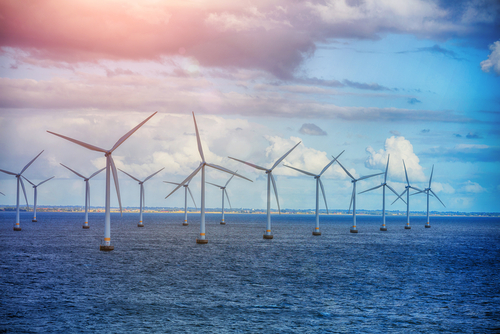DOE report analyzes offshore wind energy transmission on East Coast

Offshore wind is projected to be a key part of the energy picture for the East Coast states, according to a new report from the U.S. Department of Energy.
The DOE’s Atlantic Offshore Wind Transmission Study, conducted by researchers from DOE’s National Renewable Energy Laboratory and Pacific Northwest National Laboratory, analyzed various scenarios for offshore transmission off the Atlantic coast of United States. It estimates the costs and benefits of each pathway, accounting for grid reliability, resilience, and potential cable routes.
Overall, it found that offshore wind energy development presents an opportunity to add transmission capacity to the East Coast’s power system, with the highest benefit from offshore transmission connecting areas across grid regions. This would allow offshore wind transmission to provide energy to areas of high demand and reduce grid congestion and increase system reliability. It could also reduce generation from fossil-fueled-powered units by 5.5–9.2 Terawatt-hours per year in 2050. Ultimately, the study found that connecting offshore wind platforms together to create transmission networks outweighs the costs when compared with each project having its own isolated transmission connections. Further, the report identifies potential transmission corridors.
“Offshore wind energy is already powering more than one hundred thousand homes along the east coast, with the potential to grow and further enhance grid reliability and reduce even more fossil fuels,” U.S. Secretary of Energy Jennifer Granholm said. “The Atlantic Offshore Wind Transmission Study and the Action Plan show the Biden-Harris Administration’s commitment to advance offshore wind along the nation’s coasts will boost domestic manufacturing and support tens of thousands of jobs as we tackle the climate crisis.”
This study informed the Atlantic Offshore Wind Transmission Action Plan, which outlines immediate actions needed to connect the first generation of Atlantic offshore wind projects to the electric grid, as well as longer-term efforts to increase transmission.
The final Atlantic Offshore Wind Transmission Action Plan details how wind resources could efficiently be captured off the Atlantic Coast of the United States and delivered to communities. Over the mid- to long-term, increased intra-regional coordination, shared transmission lines, and an offshore network of high-voltage direct current (HVDC) interlinks can more efficiently bring critical, renewable offshore wind energy onshore.
The Atlantic Offshore Wind Transmission Study and report were funded by DOE’s Wind Energy Technologies Office. The Atlantic Offshore Wind Transmission Action Plan was led by DOE’s Grid Deployment Office, in partnership with the Wind Energy Technologies Office and the Department of Interior’s Bureau of Ocean Management.
